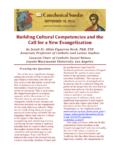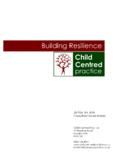Transcription of People's Voice Project International Centre for Policy Studies
1 CITIZEN participation HANDBOOKP eople's Voice ProjectInternational Centre for Policy StudiesEditorsGina Gilbreath HoldarandOlha ZakharchenkoManaging Editor Agnes NatkaniecTranslationTetyana Dihtyar and Iryna PiontkivskaPublisher"iMedia" 2002 Kyiv, UkraineFunding provided by TABLE OF CONTENTSF orewordCitizen participation in Central and Eastern Europe:A Catalyst for Reform and Monitor of Progress5 IntroductionCitizen participation Conference and Handbook9 Section IPractical Issues for Citizen Participation13 Section IICitizen participation Methodologies19 Citizen Advisory Groups21 City Strategic Planning291) Participatory Urban Assessment In Capital Planning312) Strategic Planning for Healthy Communities39 Coalition Building49 Community Organizing59 Participatory Budgeting and Capital Investment Planning71 Participatory (Action) Research81 Public Education91 Public Hearings101 Report Cards111 Social Monitoring125 Annexes131 The Role of Citizen Participationin Policy Development and Implementation133 Internet Resources on Citizen Participation139 Conference Participants144 FOREWORDCITIZEN participation IN CENTRALAND EASTERN EUROPE.
2 A CATALYSTFOR REFORM AND A MONITOR OF PROGRESSTom MonastyrskiDirector, People's Voice Project , UkraineAt the core of democratic development in Central and Eastern Europe (CEE) is the need for peo ple to believe that the politicians they elect to represent them are addressing their concerns andbest interests in improving the welfare and "quality of life" for the local community. This isincreasingly important at the municipal government level where the effectiveness and efficien cy of service delivery is more acute and where the lack of accessibility of citizens and transpar ent decision making fuels corruption, inhibits good governance and decreases the likelihood forsocial and economic improvements. In the pursuit of more effective and efficient government service delivery, a number of localgovernment bodies and representatives of civil society throughout CEE are taking activeapproaches through the implementation of a number of citizen participation mechanisms.
3 Theinternational conference that took place in Yaremche, Ukraine from November 22 25, 2001under the auspices of the People's Voice Project provided an excellent opportunity for theseindividuals to share their methodologies, the problems that they encountered and, most impor tantly, the results of their work. The conference welcomed approximately 90 participants from17 different countries throughout CEE and showcased a broad spectrum of different approach es, guidelines and possible was significant about the conference itself was that it represented a wide range of citizenparticipation methodologies and it was clear that there is an increasingly important trend toinclude the input and feedback of citizens in development of policies and programs. This trendmanifests itself in a number of ways: public hearings, community advisory councils, social mon itoring, report cards, participatory budgeting, etc.
4 Some of the participants are making moreprogress than others, but there is no doubting the existence of a collective effort pushing thereform process even further and ensuring that politicians remain accountable to the citizensthey proceedings from this citizen participation conference in Yaremche, Ukraine were not onlyabout sharing experiences and strategies. Rather, the participants used it as an opportunity tosee what their counterparts in other parts of CEE are capable of accomplishing and to build andexpand networks, both formally and informally, with them. The work being done in citizen par ticipation is only one example of the increasing influence civil society is having on the processof reforming local governments. Coupled with other development initiatives, there is a growingforce that pushes the reform agenda and proposes specific problems through monitoring servicedelivery and cooperating with local authorities in proposing Policy alternatives.
5 The opportunity to share ideas and lessons learned in citizen participation has been an impor tant part of the People's Voice Project . It is the hope of the Project management team that the5results of this conference can be used not only in the Project pilot cities (Ternopil, IvanoFrankivsk, Kupyansk and Chuguiv), but in other parts of Ukraine and CEE. The CitizenParticipation Handbook, which is the product of this conference, will be made available not onlyto participants of the conference but to partners and municipalities throughout Ukraine. It willinitially be published in Ukrainian and English, but will eventually be translated into of the handbook will be used as part of the training program associated with thePeople's Voice Project and will likely be used in the expansion of its methodology to other will also be made available on the website of the People's Voice Project ( ) and we hope that a number of practioners, academics and researchestake advantage of this resource.
6 At this time, I would personally like to thank the organizers of the conference, specifically OlgaZakharchenko, Agnes Natkaniec and Gina Holdar, for all the hard work they did in organizing andfacilitating the conference. I would also like to thank the Open Society Institute, the CanadianBureau for International Education, the World Bank and the Canadian InternationalDevelopment Agency (CIDA) for their financial support for this conference and other related ini tiatives under the auspices of the People's Voice participation CONFERENCEAND HANDBOOKThis publication contains results of the International conference "Citizen participation in theDecision Making Process at the Local Level in Central Eastern European Countries (CEE):Concepts and Practices", which took place in Yaremche, Ivano Frankivsk region, Ukraine onNovember 22 25, 2001.
7 The conference was organized by the People's Voice Project , which focus es on building integrity and improving governance at the municipal level in Ukraine, and itslocal partners the Urban Development Institute (Ivano Frankivsk) and the Institute of UrbanDevelopment (Nova Odesa). The goal of the International conference was to increase opportunities to enhance citizen par ticipation in the decision making process at the local level in CEE countries through the learn ing and sharing of concepts and practical skills. Approximately 90 individuals, including experts,representatives of NGOs, local authorities and donors participated in the conference, represent ing Ukraine, Bulgaria, Poland, Romania, Estonia, Armenia, Bosnia & Herzegovina, Georgia, theCzech Republic, Slovakia, Canada, the United States, and the United Handbook on Citizen participation is aimed at widening the impact of the International con ference.
8 It summarizes the plenary sessions, and provides step by step guidelines for the prac tical methods covered in each of the working groups during the conference. These include: Citizen Advisory Groups City Strategic Planning Coalition Building Community Organizing Participatory (Action) Research Participatory Budgeting Public Education Public Hearings Report Cards Social Monitoring The handbook covers each of these citizen participation methodologies, with discussions andpractical illustrations on how these concepts have been or might be used in the CEE Citizen participation Handbook makes the work of the conference sustainable and far reach ing. Through the distribution to conference participants, their local contacts, other Ukrainianand CEE NGOs and local officials, the work of the conference is disseminated to a wider handbook will act as a reference source for all interested parties, providing general infor mation and case Studies from the CEE countries on the topic of citizen participation .
9 Together,these initiatives serve to further the knowledge and practice of citizen participation and helpto increase their usage in local contexts throughout the CEE STRUCTUREThe Handbook begins with an outline of issues on citizen participation , which were discussedduring the plenary sessions and working groups. Subsequently, a variety of citizen participationmethodologies are presented in the following chapters. These methodologies can be applied tofacilitate dialogues between local governments and citizens in order to improve public servicedelivery. The following chapters discuss some of these techniques, which have proven to beeffective in the CEE context:Citizen Advisory GroupsThey are an important way for the Local Government Unit (LGU) to engage citizens in the processof government and to keep in touch with changing public needs between Strategic PlanningThis is an important tool for communities attempting to achieve community health, includingphysical, economic and social well being.
10 The handbook covers two types of strategic planningapproaches:a) Participatory Urban Assessment in Capital Planning, andb) Strategic Planning for Healthy CommunitiesCoalition BuildingThis methodology is necessary when one organization recognizes that by acting alone, it doesnot have the capability to successfully influence an issue and implement the desired changesCommunity OrganizingThis method focuses on how citizens should take power into their own hands and organizeamong themselves in order to implement Budgeting and Capital Investment PlanningThis method focuses on how active participation of all stakeholders is fundamental to design ing an efficient and practical budget and capital investment (Action) ResearchParticipatory research is a means of putting research capabilities in the hands of people. By uti lizing this method, citizens can identify issues themselves as knowing actors through definingtheir reality, shaping their new identity, naming their history, and transforming their EducationPublic education is a first step method for involving citizens in the life of the community andin creating a participative HearingsA public hearing can be viewed as a forum where individual citizens, citizens groups and localofficials come together to exchange information and opinions about civic issues before actionis CardsReport cards utilize survey research methods to uncover citizens' attitudes toward issues in theircommunities.
















